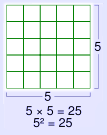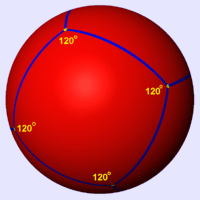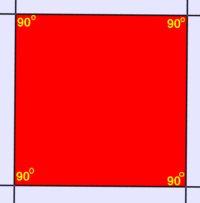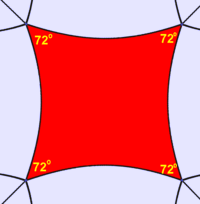In plane (Euclidean) geometry, a square is a regular polygon with four sides. Classification A square (regular quadrilateral) is a special case of a rectangle as it has four right angles and parallel sides. Likewise it is also a special case of a rhombus, kite, parallelogram, and trapezoid. The perimeter of a square whose sides have length t is P = 4t. And the area is A = t2.
The area of a square is the product of the length of its sides. In classical times, the second power was described in terms of the area of a square, as in the above formula. This led to the use of the term square to mean raising to the second power. Standard coordinates The coordinates for the vertices of a square centered at the origin and with side length 2 are (±1, ±1), while the interior of the same consists of all points (x0, x1) with −1 < xi < 1. Properties Each angle in a square is equal to 90 degrees, or a right angle. The diagonals of a square are equal. Conversely, if the diagonals of a rhombus are equal, then that rhombus must be a square. The diagonals of a square are If a figure is both a rectangle (right angles) and a rhombus (equal edge lengths) then it is a square. Other facts * If a circle is circumscribed around a square, the area of the circle is π / 2 (about 1.57) times the area of the square. * If a circle is inscribed in the square, the area of the circle is π / 4 (about 0.79) times the area of the square. * A square has a larger area than any other quadrilateral with the same perimeter ([1]). * A square tiling is one of three regular tilings of the plane (the others are the equilateral triangle and the regular hexagon). * The square is in two families of polytopes in two dimensions: hypercube and the cross polytope. The Schläfli symbol for the square is {4}. * The square is a highly symmetric object. There are four lines of reflectional symmetry and it has rotational symmetry through 90°, 180° and 270°. Its symmetry group is the dihedral group D4. Non-Euclidean geometry In non-euclidean geometry, squares are more generally polygons with 4 equal sides and equal angles. In spherical geometry, a square is a polygon whose edges are great circle arcs of equal distance, which meet at equal angles. Unlike the square of plane geometry, the angles of such a square are larger than a right angle. In hyperbolic geometry, squares with right angles do not exist. Rather, squares in hyperbolic geometry have angles of less than right angles. Larger squares have smaller angles. Examples:
See also * Cube * Pythagorean theorem * Square lattice Links * Animated course (Construction, Circumference, Area) * Eric W. Weisstein, Square at MathWorld. * Definiton and properties of a square With interactive applet Retrieved from "http://en.wikipedia.org/" |
|
||||||||||||||||||||||






